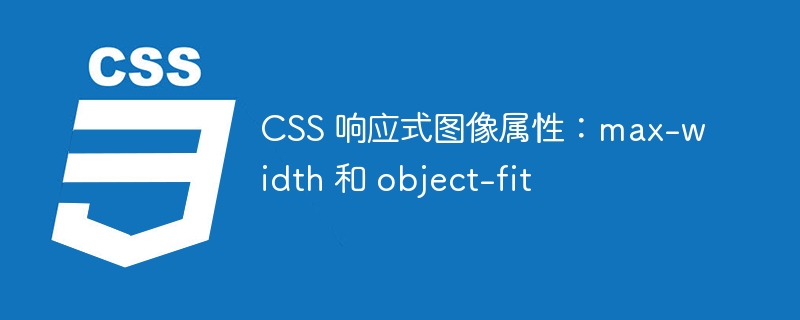Home >Web Front-end >CSS Tutorial >CSS responsive image properties: max-width and object-fit

CSS responsive image attributes: max-width and object-fit, specific code examples are required
With the popularity of mobile devices and the diversification of website visits, responsiveness Style design has become one of the essential skills for modern website development. In responsive design, the adaptability of images is an important consideration. CSS provides some properties, notably max-width and object-fit, that make it easy to handle the adaptability of images to different screen sizes and layouts.
The max-width attribute is used to control the maximum width of an element. For image elements, you can set max-width: 100% to ensure that the image scales adaptively within its container. This means that the width of the image will adjust based on the size of the container to accommodate different screen sizes or layout changes. Here is an example using max-width:
img {
max-width: 100%;
height: auto;
}In the above example, by setting max-width to 100%, the width of the image will be limited to the maximum width of its container. At the same time, setting height to auto means that the height of the image will be automatically adjusted according to the width adjustment, maintaining the original aspect ratio.
In addition to max-width, object adaptability is also a key issue in responsive design. In the past, we used to resize the image by setting its width and height, but this approach would cause the image to be distorted or cropped. CSS3 introduced the object-fit property to control the fit of an object (such as an image) within its container.
The object-fit attribute has three common values: fill, contain and cover. The fill value will force the image to fill its container, possibly causing distortion of the image. The contain value will scale the image into the container, maintaining its original aspect ratio and ensuring that the image is fully visible, but may leave empty space within the container. The cover value will fill the entire container, possibly cropping part of the image. Here is an example using object-fit:
img {
width: 100%;
height: 300px;
object-fit: cover;
}In the above example, the width of the image is set to 100%, the height is 300px, and object-fit is set to cover. This will cause the image to completely fill the container, and crop any portion that extends beyond the container. If the aspect ratio of the object does not match the container, the image will be stretched or compressed to fit the container.
Here are some sample codes using max-width and object-fit attributes, which can help developers better understand their usage and apply them in responsive design.
<!DOCTYPE html>
<html>
<head>
<style>
.container {
width: 500px;
margin: 0 auto;
}
img {
max-width: 100%;
height: auto;
}
.fit-container {
width: 300px;
height: 200px;
overflow: hidden;
}
.fit-container img {
width: 100%;
height: 100%;
object-fit: cover;
}
</style>
</head>
<body>
<div class="container">
<img src="image.jpg" alt="Responsive Image">
</div>
<div class="fit-container">
<img src="image.jpg" alt="Responsive Image">
</div>
</body>
</html>In the above example code, we create an outer container, set the width of the container and center align it. Image elements are scaled responsively by setting max-width: 100%. Additionally, we create an explicit container to demonstrate the use of the object-fit attribute. The container has an aspect ratio of 3:2, the image fills the container with the cover value, and is cropped beyond the container by setting overflow: hidden.
In summary, the max-width and object-fit attributes are important tools for achieving image adaptability in responsive design. max-width allows the image to adaptively scale according to the container, maintaining normal display across different screen sizes or layout changes. object-fit allows developers to more precisely control how the image fits within the container, as well as how the image is filled and cropped. Developers can choose appropriate attribute values according to their needs and combine them with other CSS properties to achieve better responsive image effects.
The above is the detailed content of CSS responsive image properties: max-width and object-fit. For more information, please follow other related articles on the PHP Chinese website!